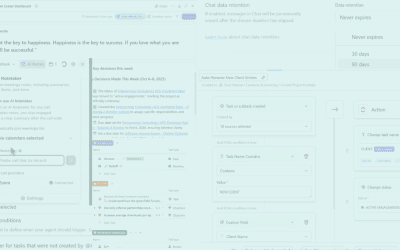
Summary: As project managers in a constantly evolving technological landscape, efficiency is not solely measured by the completion of an AI implementation project, but also by the knowledge and versatility required to use these tools across different project sectors.
While “AI” might be a buzzword, it’s more than that. It’s becoming a core driver of efficiency, innovation, and competitive advantage across industries. With new tools and frameworks emerging quite literally everyday, how do you implement AI effectively? It’s not as easy as plugging it in and walking away. Jessica Caresse White, a Senior Project Manager at Tuck Consulting Group and the Managing Director of J. Caresse & Company, breaks down from first-hand experience, how to effectively implement AI for your organization.
How to Implement AI for Your Organization
Let’s get into it.
Current state assessment of current process + workflows.
Before you implement any tools (even non-AI tools), you have to understand what the current landscape looks like.
- What projects are in progress?
- How are you currently approaching projects and why are you doing it this way?
- What are the limitations, pain points, and existing tech stack?
Last but not least, define WHY you want AI in your organization. This is going to be key to keeping your team focused throughout the implementation. Document all of your findings, and especially your “why”, in a straightforward manner.
Evaluate existing technology.
Now that you’ve defined the current state tech stack, it’s time to evaluate the current tools. Do they have AI tools or capabilities embedded that you just aren’t using?
It’s not uncommom for project managers to uncover situations where organizations are paying for tools they aren’t fully utilizing.
From here, it’s time to triage the organizations needs. Which areas of the business will benefit the most from AI aid? Do you have existing tools that address this? If not, revisit your “why” and then begin researching AI tools that align with this direction.
Implement AI Strategically
A project manager leading AI adoption should be educated in AI tools or leverage resources like Gemini Deep Research to get up to speed on the industry or tools they’re dealing with.
Getting Started
If your primary goal is “implement AI”, or “implement [specific AI tool]”, the first step is to break that up into smaller milestones. Work with subject matter experts to develop specific use cases for how they desire to use AI (your research should confirm whether or not the tool can support this. That isn’t a surprise you want to hit the client with four weeks into the implementation).
The output of this step is:
Qualitative Documentation
In the form of use case project charters. Leveraging the confirmed use cases, these charters should spell out the why, what, who, when, and dependencies.
Solution Design
If you have an architect at your disposal, work with them to define the client’s tool requirements, limitations, capabilities, and wish list. This is where you capture your “known knowns” and “known unknowns”.
Spoiler alert: AI can help you through this step.
Four Ways to Leverage an LLM
- Review and comment on solution designs using project charters as context. (Don’t forget to scrub the charters for client information).
- Validate timeline estimates with team input.
- Generate user stories for engineers.
- Produce test plans or test cases.
Misconceptions Around AI in the Enterprise Space
While AI is immensely beneficial, it’s crucial to recognize common misconceptions about its implementation. As AI continues to reshape work environments and processes, understanding these misconceptions becomes increasingly important.
Misconception #1: AI Can Do Everything
AI is, at its core, a tool! New AI tools are being launched everyday, and their marketing is tailored more to small businesses instead of large, complex organizations. Additionally, AI models are rapidly updated; if you aren’t maintaining them, they will fully derail your operations.
Misconception #2: AI is a Silver Bullet
There are many misleading articles surrounding AI. How many times have you seen a clickbait article go something like, “AI laid off X number of employees because AI fully replaced the capabilities of a department.”
When you see these articles remember – if you lay off your team and later realize that you can’t just “set and forget AI”, you’ll have to rehire all of those people. And we all know how expensive that’s going to be.
Misconception #3: Individuals do not have to be educated on AI to use it
While anyone can access these open-source AI tools, it is to the organization’s benefit to provide training around AI. By providing education regarding AI companies, you will better highlight limitations pertinent to their organization, specifically, the guardrails you need in place to get accurate, consistent quality results.
If your goal is to successfully implement AI at your organization, it’s not about the latest, shiniest tool. A successful implementation comes down to thoughtful strategy, clear objectives, and a clear understanding on how to use it effectively. When used responsibly, AI can be a practical advantage to support your orgs long-term goals.

Jessica Caresse White
Project Management Consultant
Jessica Caresse White (she/her), PMP, CSM, has been a Senior Project Manager with Tuck Consulting Group since May 2024. She is also the Managing Director of J. Caresse & Company, a consulting firm redefining success in business by putting people first. She’s worked at industry giants like Cisco Systems, Hitachi Solutions, and McKinsey & Company leading teams through complex, high-stakes projects.
Outside of work, Jessica runs a podcast, Connecting the Dots, where she enjoys meeting new people, learning about their life journey, and inspiring her audience.

